 Author: Eiji OKUBO Sales Network: Amazon.com / Amazon.co.jp |
| Written by Eiji Okubo, Printed books and e-books Heritage of Minoan and Mycenaean civilizations Detailed data on Ruins and Excavated items |
| The World of Crafts and Arts of the Mycenaean Civilization "Swords and Daggers" |
 |
| subtitle: Data and explanations of excavated items language: English format: Paperback printing paper: Non-glossy high-quality paper printing ink: High-saturation premium ink size: 8in.x10in. (203mm x 254mm) 262 pages sales: Amazon Network / Amazon.com / Amazon.co.uk |
| Sumary: This book is 8in. x 10in. (203mm x 254mm) version, 260 pages, a “Precision Illustrations & Data Book” of excavated items from the prehistoric Mycenaean Civilization ruins in mainland Greece. This book is picking up 65 items of outstanding Mycenaean Bronze Swords and Daggers excavated from important ruins of the Mycenaean Civilization in Greece, including the Mycenae Palace and surroundings ruins, which were the center of the Civilization. Almost all of the excavated items are explained with precise illustrations. In addition, the book also contains 180 related images and information, including ruins related to the excavated these items, as well as gold and silver jewelry, pottery and stone seals excavated from the same places. This book will invite you to the “World of Crafts and Arts” of the Mycenaean Civilization through carefully selected important works from among the excavated items on display at the National Archaeological Museum of Athens and other archaeological museums in Greece. Contents: I What is the Mycenaean civilization? II Minoan & Mycenaean Bronze & Swords III Mycenaean Bronze Decorated Swords& Daggers III-1 Decorated Sword, Gold Hilt III-2 Decorated Sword, Special material Handle III-3 Decorated Dagger, Geometric pattern inlay III-4 Decorated Dagger, Animal inlay III-5 Decorated Dagger, Marine life inlay III-6 Decorated Dagger, Various inlays III-7 Decorated Dagger, Gold and Silver rivets IV Mycenaean Bronze Weapons & Armed IV-1 Bronze Sword IV-2 Bronze Dagger IV-3 Bronze Knife IV-4 Bronze Spearhead & Axe IV-5 Bronze Armament V Mycenaean Everyday Knives V-1 Bronze Razor V-2 Bronze Cleaver (Kitchen Knife) |
| Sample Page: (excerpt) ---------- III-1-02 Type-B Sword, Spiral line & Stipple patterns 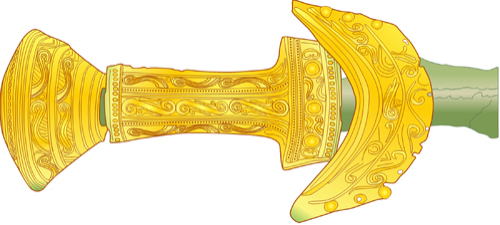 Site: Shaft Grave V, GCA, Mycenae Palace Shape & Decoration: Bronze Sword of the “Type-B” with gold-plated hilt gold rivets, gold mouth of sheath, exquisite spirals and stipple pattern in repoussé Era: LHI, ca. 1550 BC Museum: NAM, inv. No. 763 Local: Argolis, Peloponnese Drawing: Eiji OKUBO Related: Royal Tomb GCA In 1876, German businessman J.H. Schliemann discovered a double stone slab circle with a maximum outer diameter of 27.5m inside the citadel of the Mycenae Palace ruins in the Peloponnese-Argolis region, currently a UNESCO World Heritage Site. The circular ruins were a large cemetery called Grave Circle A (GCA), which dates back to the 16th century BC. Grave Circle A in the Mycenae Palace is located immediately to the right of the interior after entering through the Lion Gate, the main gate of the palace area. 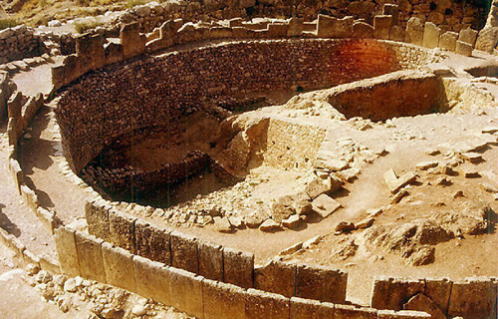 Site: Grave Circle A, Mycenae Palace Situation: A unique Mycenaean cemetery a) double slab circle=outer diameter 27.5m, inner 25m b) center left tomb=largest Shaft Grave IV c) center right tomb=Shaft Grave I Era: MHIII-LHI, 1625-1500 BC Local: Argolis, Peloponnese / 11km north-northeast from Argos city Photo: 1982 GPS: 37°43'49.50''N 22°45'23''E / ALT 240m Currently, we can see that Grave Circle A is located "inside" the walls of the Mycenaean Palace. However, the Palace Rampart surrounding the mansions in the northwestern part of the palace, from the Lion Gate to the Southern Wing, including Grave Circle A, was expanded and built in the Late Helladic LHIIIB period, around 1250 BC. From the time of the burials to several centuries later, for about 350 years, therefore, Grave Circle A was located "outside" the early Palace Rampart surrounding the Acropolis. 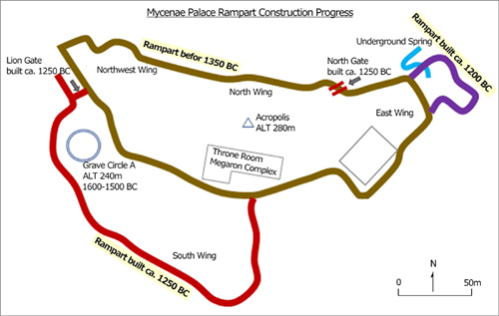 Construction progress of the Mycenae Palace Rampart a) 1st period: built before 1350 BC (brown) b) 2nd period: built ca. 1250 BC (red) c) 3rd period: built ca. 1200 BC (purple) Local: Argolis, Peloponnese Drawing: Eiji OKUBO Construction and burial of Grave Circle A date back to the late 17th century BC, the Middle Helladic MHIII period, around 1600 BC, and subsequent burials continued for about 100 years until the end of the Late Helladic LHI period, around 1500 BC. The Middle Helladic MHIII period was a period when the Mycenaean civilization showed signs of rapid expansion, and the excavations revealed Grave Circle A, which had an extremely unique burial style never seen before. And the high quantity and quality of its luxurious grave goods from 6 shaft graves are reminiscent of the presence, rapid rise and power of the ruler of the Mycenae Palace at the time, who was buried in Grave Circle A. Shortly before burials in Grave Circle A began around 1600 BC, on the Mycenae Acropolis, a rocky ridge, it can be assumed that there was an early Mycenae Citadel, a small palace-class fortified, although it is not clearly known. Grave Circle A was a tomb type that was rare among prehistoric civilizations in the Aegean region. With the exception of a few examples, such as the small circular tomb at the Palace of Nestor in the Messenian region and the small circular tomb at the Samikon site, 10 km northwest of Kakovatos in the Elis region, large circular tombs like Grave Circle A are very unique in other regions of the Mycenaean civilization, or even in the Minoan civilization that flourished on Crete at the same time. III-1-05 Type-B Sword, chained Cross pattern  Site: Royal Tholos Tomb, Dendra Shape & Decoration: Bronze Sword of the “Type-B” a) ivory pommel with gold rivet b) hilt=gold decorated, chained cross pattern in repoussé Era: LHIIIA, 1400-1300 BC Museum: NAM, inv. No. 7325 / L500mm Local: Argolis, Peloponnese Drawing: Eiji OKUBO Related: Royal Tholos Tomb of Dendra and Excavated Items The Mycenaean Tholos Tomb at Dendra is a medium-sized tomb with an inner diameter of 7.3m, and the dromos passageway is 18m long. The ceiling of the tholos had collapsed at the time of excavation, but it is estimated that the original ceiling at the time of construction was approximately 7m high. Two people, a man and a woman, were buried in the pit on the floor inside the tholos. Based on the luxurious grave goods excavated, the two buried were thought to be a king and queen from the early 14th century BC who lived in a palace on the walled acropolis hill of Midea, 1.6km southeast of Dendra. For this reason, this tomb is called the "Royal Tholos Tomb". 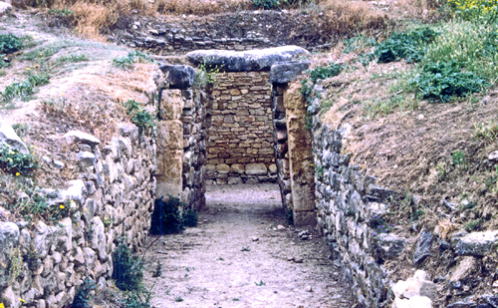 Site: Royal Tholos Tomb, Dendra View from Dromos to Entrance with Lintel stone and Tholos chamber Style: Mycenaean Tholos Tomb with collapsed ceiling a) Tholos chamber inner diameter 7.3m b) burial chamber=Semi-underground type c) Dromos length 18m Era: LHIIIA, 1400-1300 BC Local: Argolis, Peloponnese currently equipped with a protective roof Photo: 1987  Site: Royal Tholos Tomb, Dendra Shape & Decoration: Shallow Gold Cup ring-handle dolphins, octopus, underwater reef in repoussé in Marine design Era: LHIIIA, 1400-1300 BC Museum: NAM, inv. No. 7341 / mouth diameter D178mm Local: Argolis, Peloponnese Photo: 1987 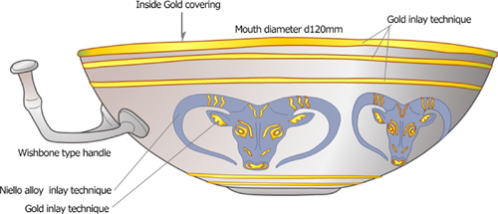 Site: Royal Tholos Tomb, Dendra Shape & Decoration: Silver Cup with wishbone handle, gold covering inside gold lines outside mouflon-heads (or bull) of gold and niello inlaid decoration Era: LHIIIA, 1400-1300 BC Museum: NAM, inv. No. 7336 / mouth diameter D120mm Local: Argolis, Peloponnese Drawing: Eiji OKUBO 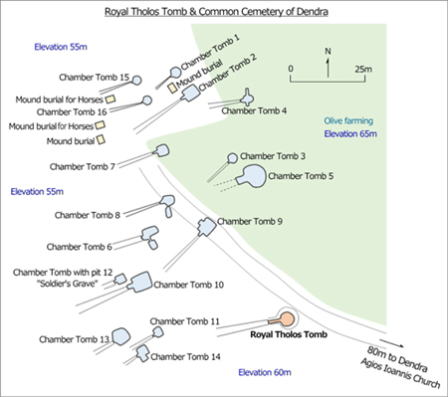 Site: Plan of Common Cemetery, Dendra Situation: Royal Tholos Tomb, Chamber Tombs, Mound burials Local: Argolis, Peloponnese / 7km north-northeast from Tiryns Palace Drawing: Eiji OKUBO GPS: 37°39'24''N 22°49'32''E / ALT 60m 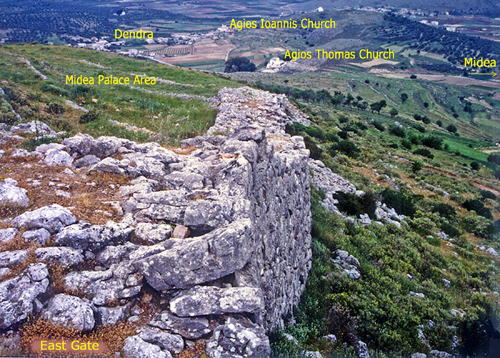 Site: Midea Palace Area Situation: East Gate and Ramparts, Cyclops-style masonry a) left side of ramparts=Palace Area b) far left, northwest 1.6km=Dendra village, Royal Tholos Tomb and Common Cemetery c) right=Midea village, 1km northeast from Agios Thomas Church Era: Palace construction, LHIIIA1, ca. 1400 BC Local: Argolis, Peloponnese / 7km north-northeast from Tiryns Palace Photo: 1996 GPS:37°38'59''N 22°50'31''E / ALT 250m Related: Minoan Bronze Sword, Gold Hilt 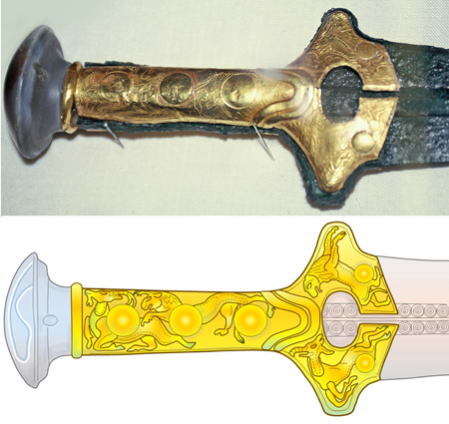 Site: Shaft Grave 36, “Chieftain's Grave,” Zafer Papoura Shape & Decoration: Bronze Sword of the “Type-D,” gold decorated grip-handle a) decorative motif=lion threatening and attacking wild goat b) agate pommel, spiral pattern on blade Era: LMII-LMIIIA1, 1450-1350 BC Museum: HAM, inv. No. 1098 / L610mm Local: Central North, Crete Drawing: Eiji OKUBO During the excavation mission of Sir Arthur John Evans, numerous tombs totaling 100 were discovered in the Zafer Papoura necropolis in a gently sloping olive field and where located 1km north of the Minoan palace ruins of Knossos. The large cemetery is measuring approximately 200m north to south and 140m east to west, and these excavated tombs included 33 shaft graves, 49 chamber tombs, and 8 pit graves. This medium-sized "Type-D Sword" with a 610mm long, parallel-striped onyx-agate pommel was excavated from Shaft Grave 36, also known as the Chieftain's Grave, and has a total of five rivets: three (large) on the grip handle and two (small) on the shoulder section. The pommel side of the handle depicts a lion attacking a fleeing wild goat from its waist to its hind legs, and the shoulder section depicts a scene of the lion and wild goat looking back at each other as they check each other, all in gold repoussé. It is a wonderful piece that depicts a world of wild animals where the survival of the fittest, with the strong lion and wild goat showing their wariness of each other, and the next moment the lion begins a fierce attack, with elements of "narrative" glimpses hidden in the sword's decoration, even in a small space. In addition, the center lines on both the front and back of the blade have a raised reinforced rib each, and are also engraved with double-row linked spiral patterns. The burial victim of the tomb was likely a male occupying Mycenaeans of extremely high rank. III-2-01 Type-D Sword, Agate mounting Hilt  Site: Chamber Tomb 81, Kalkani, Mycenae Shape & Decoration: Bronze Sword of the “Type-D” a) hilt=striped pattern agate decoration, gold buttons and crimping b) flanged shoulder Era: LHIIB-LHIIIA1, 1450-1375 BC Museum: NAM, inv. No. 3110 hilt (grip handle and shoulder part) length L85mm Local: Argolis, Peloponnese Drawing: Eiji OKUBO III-4-03 Tangles type Dagger, Lion attacking Waterfowl 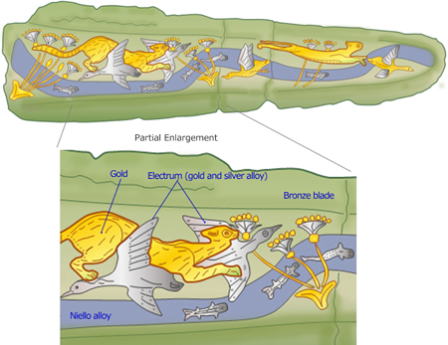 Site: Shaft Grave V, GCA, Mycenae Palace Shape & Decoration: Bronze Dagger of the “Tangles type” inlaid decoration of gold, niello, electrum alloy: two lions (or leopards) attacking waterfowl, fish swimming in the river Era: LHI, ca. 1550 BC Museum: NAM, inv. No. 765 / L165mm Local: Argolis, Peloponnese Drawing: Eiji OKUBO III-5-01 Tangles type Dagger, Dolphin pattern 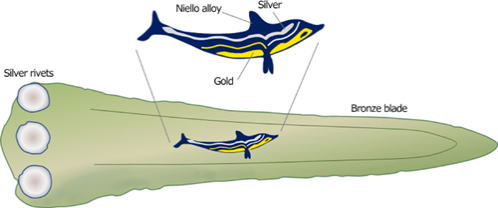 Site: Chamber Tomb 14, Heraion (old name Prosymna) Shape & Decoration: Bronze Dagger of the “Tangles type” a) inlaid decoration of gold, silver, niello alloy, dolphin on each side of the blade b) silver rivets on the shoulder part Era: LHII, 1500-1400 BC Museum: NAM, inv. No. 8446 dagger length L186mm / dolphin length L38mm Local: Argolis, Peloponnese Drawing: Eiji OKUBO Related: Excavated Item from Chamber Tomb 14, Heraion 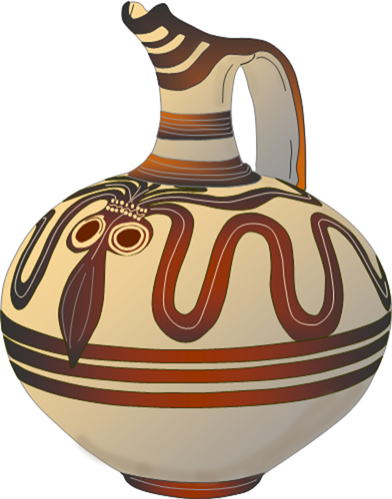 Site: Chamber Tomb 14, Heraion (old name Prosymna) Shape & Decoration: Spherical Beaked Jug octopus and thick lines patterns in Marine design Era: LHII, 1500-1400 BC Museum: NFAM, inv. No. 5505 / H240mm Local: Argolis, Peloponnese Drawing: Eiji OKUBO III-5-03 Gold inlay parts for Dagger  Site: Royal Tholos Tomb, Vaphio Shape & Decoration: Gold inlaid parts for Bronze Dagger flying-fish shape, blade unexcavated Era: LHIIA, 1500-1450 BC Museum: NAM, inv No. 1808 Local: Laconia, Peloponnese Drawing: Eiji OKUBO 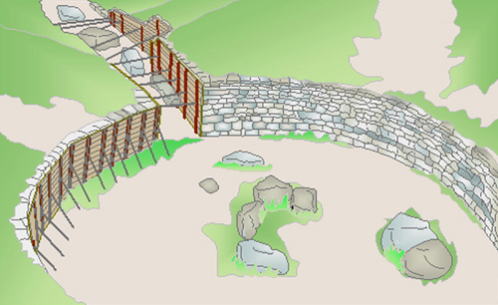 Site: Royal Tholos Tomb, Vaphio (as of 1982) Situation: Mycenaean Tholos Tomb a) Burial tomb for Royal Family of Menelaus b) Tholos chamber inner diameter 10m c) Tholos remaining wall height 1.6m Era: LHIIA, 1500-1450 BC Local: Laconia, Peloponnese Drawing: Eiji OKUBO GPS Royal Tholos Tomb: 37°01'13''N 22°28'04''E / ALT 195m 7km south-southeast from Sparti city GPS Menelaion Palace: 37°03'58''N 22°27'15''E / ALT 280m 2km southeast from Sparti city III-6-01 Tangles type Dagger, Lily pattern  Site: Shaft Grave V, GCA, Mycenae Shape & Decoration: Bronze Dagger of the “Tangles type” a) gold hilt lily flowers on the hilt in repoussé b) lily flowers of niello and electrum alloys inlay technique on the blade Era: LHI, ca. 1550 BC Museum: NAM, inv. No. 764 / L180mm Local: Argolis, Peloponnese Drawing: Eiji OKUBO IV-1-03 Type-A Swords  Site: Circular Tomb, Nestor’s Palace Shape & Decoration: Bronze Sword of the “Type-A” Era: LHI-LHII, 1550-1400 BC Museum: CHAM, inv. No. 2188 / L825mm Local: Messenia, Peloponnese Drawing: Eiji OKUBO Site: Circular Tomb, Nestor’s Palace Shape & Decoration: Bronze Sword of the “Type-A” Era: LHI-LHII, 1550-1400 BC Museum: CHAM, inv. No. 2198 / L687mm Local: Messenia Peloponnese Drawing: Eiji OKUBO Related: Excavated Items, Circular Tomb, Nestor’s Palace 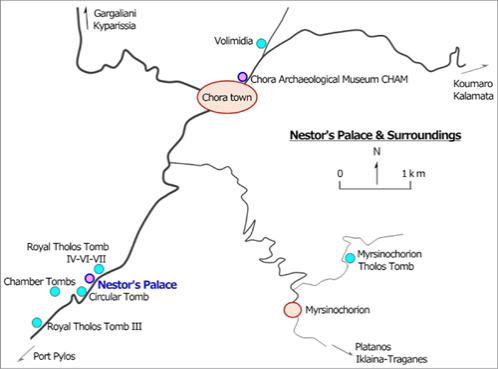 Nestor’s Palace and surroundings Local: Messenia, Peloponnese Drawing: Eiji OKUBO 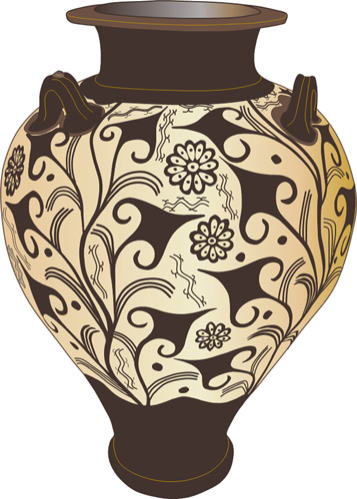 Site: Circular Tomb, Nestor’s Palace Shape & Decoration: Palace style, Amphora type Jar, ivy leaf, rosette patterns in floral design Era: LHI-LHII, 1550-1400 BC Museum: CHAM, inv. No. 1586 / H703mm Local: Messenia, Peloponnese Drawing: Eiji OKUBO ---------- |